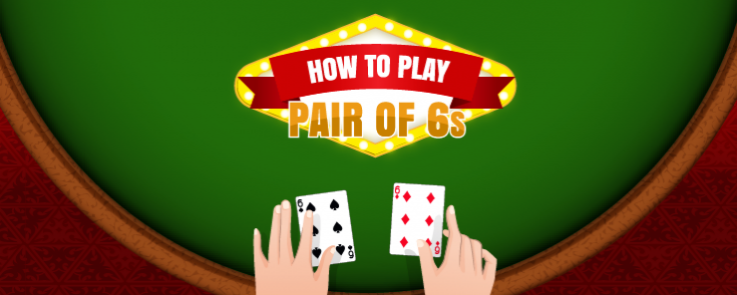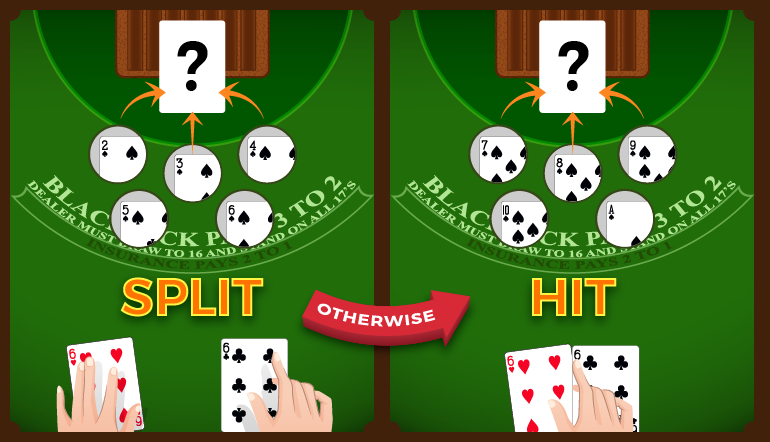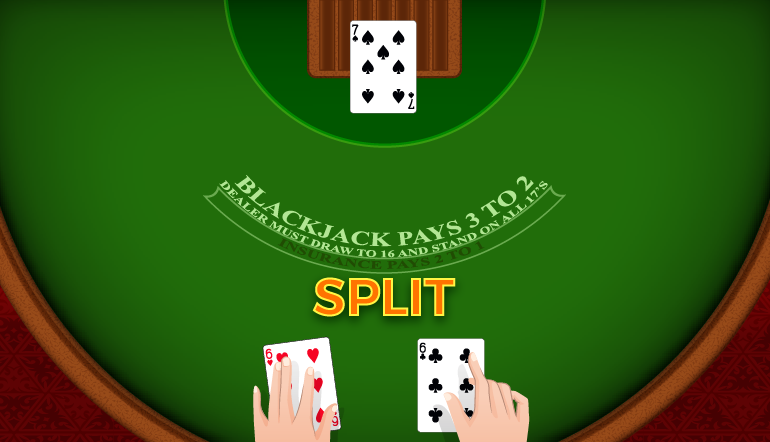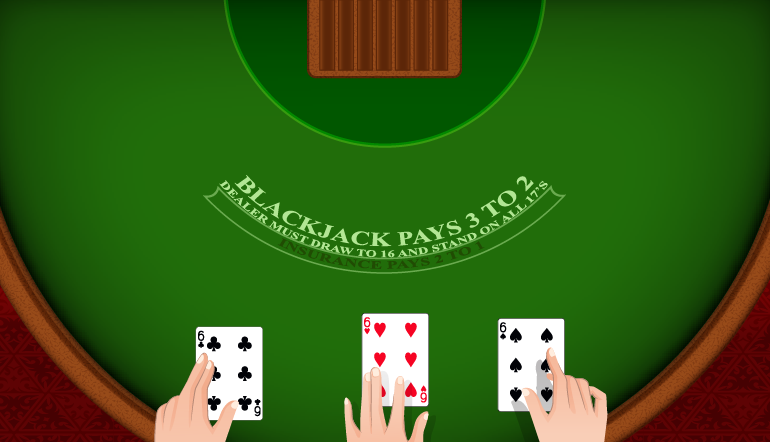How to Play a Pair of 6s

By Anonymous
|
|
When you are dealt a pair of 6s in the game of blackjack you have two viable playing options:
The basic playing strategy for a single- and double-deck game where doubling down after pair splitting is not allowed (NDAS) is to
If the blackjack rules allow doubling down after pair splitting (DAS)
In a multi-deck game, the basic playing strategy is
Single-Deck with NDAS
Single-Deck with DAS
Double-Deck with NDAS
Double-Deck with DAS
Multi-Deck with NDAS
Multi-Deck with DAS
- Split
- Hit
The basic playing strategy for a single- and double-deck game where doubling down after pair splitting is not allowed (NDAS) is to
- Split 6s against a dealer’s upcard of 2 through 6; otherwise hit

If the blackjack rules allow doubling down after pair splitting (DAS)
- You should also split against a dealer’s upcard of 7 (Illustrate splitting against 2, 3, 4, 5, 6, and 7.)

In a multi-deck game, the basic playing strategy is
- If NDAS, split against a dealer’s upcard of 3 through 6; otherwise hit
- If DAS, split against dealer’s upcard of 2 through 6; otherwise hit
Single-Deck with NDAS
| 2 | 3 | 4 | 5 | 6 | 7 | 8 | 9 | 10 | A |
| P | P | P | P | P | H | H | H | H | H |
Single-Deck with DAS
| 2 | 3 | 4 | 5 | 6 | 7 | 8 | 9 | 10 | A |
| P | P | P | P | P | P | H | H | H | H |
Double-Deck with NDAS
| 2 | 3 | 4 | 5 | 6 | 7 | 8 | 9 | 10 | A |
| P | P | P | P | P | H | H | H | H | H |
Double-Deck with DAS
| 2 | 3 | 4 | 5 | 6 | 7 | 8 | 9 | 10 | A |
| P | P | P | P | P | P | H | H | H | H |
Multi-Deck with NDAS
| 2 | 3 | 4 | 5 | 6 | 7 | 8 | 9 | 10 | A |
| H | P | P | P | P | H | H | H | H | H |
Multi-Deck with DAS
| 2 | 3 | 4 | 5 | 6 | 7 | 8 | 9 | 10 | A |
| P | P | P | P | P | H | H | H | H | H |
REASON FOR SPLITTING
Splitting 6s becomes the better option than hitting if it meets one of these criteria:
- You will win more money on average
or - You will lose less money on average
or - You will turn a losing hand into a winning hand on average
Suppose you are playing a double-deck game with DAS and the dealer’s upcard is a 2. You are the underdog regardless which strategy you invoke; however, splitting has a less negative expectation than hitting, making it the better play. (In other words, you’ll lose less money in the long run by playing two hands, each starting with a 6, than by playing one hand starting with a total of 12.)
In a multi-deck game with NDAS, hitting 6s against a dealer’s 2 is a non-intuitive play. This is another example where invoking either strategy (hitting or splitting) results in a negative expectation of winning; however, when you hit, you will lose slightly less money than splitting in the long run, making it the better play.
Another non-intuitive play is to split 6s against a dealer’s 7 upcard in single- and double-deck games with DAS. With the favorable option of DAS, when you split 6s and draw, say, a 5 to one or both 6s, you have a favorable total of 11 to double. With DAS, pair splitting has a less negative expectation than hitting against a dealer’s 7 upcard, making it the better play.
You may find the following two rules an easy way to remember how to play your 6s:
In a multi-deck game with NDAS, hitting 6s against a dealer’s 2 is a non-intuitive play. This is another example where invoking either strategy (hitting or splitting) results in a negative expectation of winning; however, when you hit, you will lose slightly less money than splitting in the long run, making it the better play.
Another non-intuitive play is to split 6s against a dealer’s 7 upcard in single- and double-deck games with DAS. With the favorable option of DAS, when you split 6s and draw, say, a 5 to one or both 6s, you have a favorable total of 11 to double. With DAS, pair splitting has a less negative expectation than hitting against a dealer’s 7 upcard, making it the better play.
You may find the following two rules an easy way to remember how to play your 6s:
- In a single- and double-deck game with DAS, split 6s against dealer’s 2‒7; otherwise hit. If NDAS, split against 2‒6.
- In a multi-deck game with DAS, split 6s against dealer upcard of 2‒6; otherwise hit; if NDAS, split against 3‒6.
RESPLITTING 6S
If the playing rules allow you to resplit, then it is advantageous for you to do so. For example, if you are dealt a pair of 6s against a dealer’s 5 upcard, you should split them. Suppose on the first 6, you are dealt another 6 on the draw. You should resplit to form a third hand. If the casino allows resplits up to a total of four hands, then you should resplit again if you are dealt another 6. Resplitting pairs is a player-favorable option that you should always take advantage of.


SUMMARY
You will always win more or lose less if you follow the above basic playing strategy for splitting or hitting a pair of 6s.
For a complete basic playing strategy for any set of playing rules, consult Chapter 3 in the Ultimate Blackjack Strategy Guide.
For a complete basic playing strategy for any set of playing rules, consult Chapter 3 in the Ultimate Blackjack Strategy Guide.


